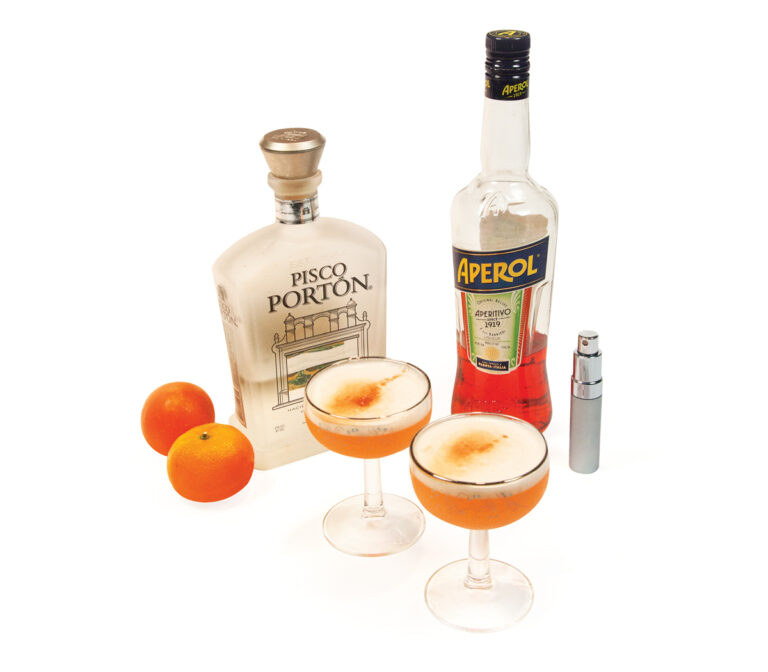Vesperoni
Shaking Up Quince to Convince

It might just be the devil in me that’s here to tempt you with some quince. A cousin to apples and pears, according to some scholars quince might be the Biblical fruit the serpent presented unto Eve with a sinful hard sell.
While it’s been cultivated for millennia—it’s been claimed that in ancient Greece a bride would munch a bit on her bridal night to freshen her breath—it’s pretty much out of favor today, at least in the U.S. If we know it, it’s probably as membrillo on a cheese plate, providing a punchy fruit paste to accompany our Manchego.
But then there’s Dunjevača, a popular Serbian liqueur distilled from quince. Given Marko Suput from Rock 12 Distillery comes from a long line of Serbian distillers, it’s not surprising for him to try his hand at a quince liqueur. He is kind enough not to make us struggle with the pronunciation of Dunjevača, though. While apple and apricot trees dominate the Rock 12 orchards, quince have increased from a mere 10 trees originally to 60 more added this season and another hundred planned for planting the next.
“We thought we were just going to make some for home consumption, but then it took off in the tasting room,” Marko Suput says. And they realize it’s a drink that needs to be sold in person, as its unusual and lovely profile can win people over even if they are unfamiliar with the fruit. Not to mention, they can help people say “kwinz” and not a pronunciation more likely in this land of Spanish-speakers, “KEEN-say.”
The Rock 12 quince liqueur is floral, with notes of apple and pear—they add just a bit of sugar to counter the quince’s infamous natural astringency and a hit of cinnamon to push the baking-spice notes. Chilled, it would work as an aperitif; room temperature, a digestif. But as for its use in a cocktail, at first the Suputs were a bit stumped. Eventually, Marko suggested a quince hot toddy; Sarah likes to sub it in for the demerara sugar in an Old Fashioned.
I decided to complicate things. (I know, dear reader, you are shocked.) First, quince is unique: Cydonia oblonga is the only member of its genus. Second, given quince seems a kind of amalgam of apple and pear, I thought a combo cocktail might be in order. Hence, the Vesperoni—part Vesper, part Negroni, all boozy in-your-face delight. (Think of it as the kindest of punches.)
What’s more, you could make this with all Rock 12 product, as their quality gin and vodka would certainly nail the Vesper roots of the drink in a way James Bond would like. And then the cocktail even includes some Meyer lemon juice, so you have more of a reason to insist it be shaken and not stirred, beyond Ian Fleming’s whims.
That lemon is crucial as it bridges the fruit and spice of the quince liqueur, a mere 30% ABV, to the more potent potables of the gin and vodka. Note the Rock 12 gin also features some lemon peel notes, but what sings Southern California more? The addition of the sage also adds to the local terroir, dueting with the gin’s juniper and expanding the herbal palate, especially by inviting your nose into the glass with the one-leaf garnish.
How is this a Negroni, you may ask? One way to think of the quince liqueur is akin to an amaro, but one on the lighter side of the bitter continuum, like a fruitier Campari that’s golden, not fire-truck red. Sure, there’s no vermouth in the Vesperoni, but then there’s no Lillet blanc, either. It’s not like I aspire to be Willem Dafoe’s character in Poor Things, surgically sewing a goose’s head onto a basset’s body.
Developing a cocktail is about delight and not shock. And yes, Rock 12 does make a pleasing amaro of their own that certainly deserves a place in something Negroni-esque. But I couldn’t resist the challenge of quince. After all, even Pliny the Elder extolled it back in the day. So it’s enthralling to see it make a brilliant appearance in the Santa Ynez Valley.







